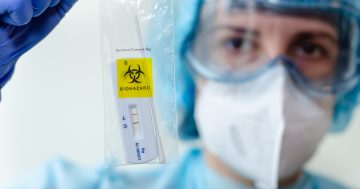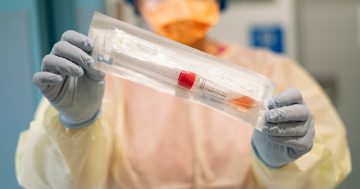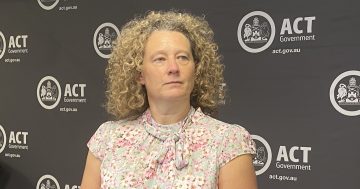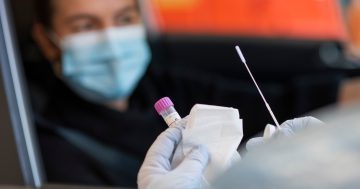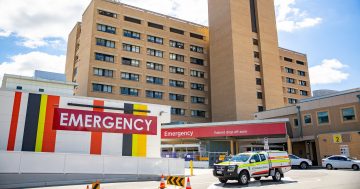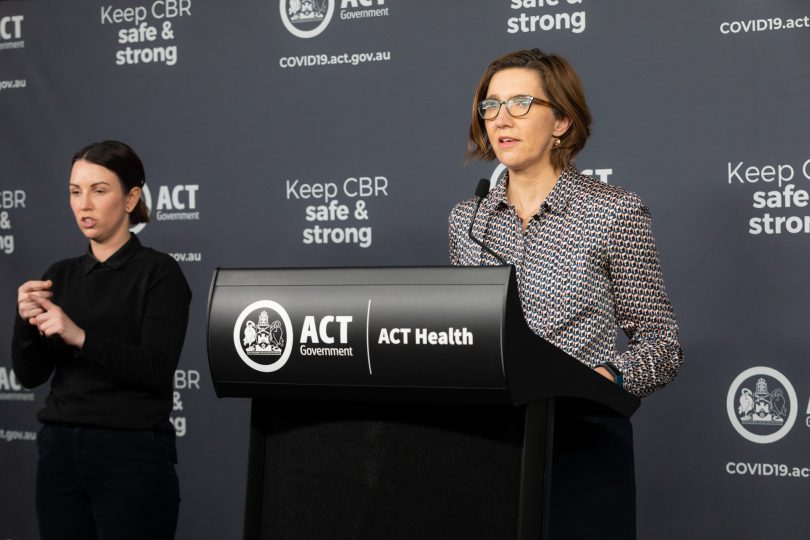
ACT Health says the new variant of Omicron – BA2 – could become the dominant strain in coming weeks. Photo: Michelle Kroll.
ACT Health says it’s likely the BA.2 sub-variant of Omicron could become the dominant strain of COVID-19 in coming weeks, as the Territory records another 791 new local cases of the virus overnight.
Three deaths with COVID-19 were also reported – a man in his 70s, a man in his 80s, and another woman in her 80s.
It’s the highest number of deaths the ACT has ever reported in a single 24-hour period and takes the Territory’s pandemic death toll to 37.
However, ACT Health says one of the deaths occurred in February.
ACT Health has extended its condolences to the family and friends of these people.
NSW is expecting a similar situation, with the state’s Health Minister Brad Hazzard warning yesterday case numbers could double within the next four to six months.
Acting Chief Health Officer Dr Vanessa Johnston said local daily caseloads are expected to rise to around an average of 800 a day but it’s unclear if they will then stabilise.
Early reports indicate the BA.2 variant could be even more infectious than BA.1 but there’s no evidence it can evade vaccines or cause more serious disease, epidemiologists believe.
Dr Johnston said infection from BA.1 should provide immunity from BA.2.
However, ACT Health is only able to conduct genome sequencing on positive PCR samples – which currently amount to about half of all positive cases reported. Positive results returned via a rapid antigen test cannot be sequenced.
“Due to the number of cases currently in the ACT, genomic sequencing (to determine virus strain) is being undertaken on less than 10 per cent of cases.
“Sequencing is prioritised for hospitalised cases, outbreaks in high-risk settings and returned overseas travellers,” a spokesperson for ACT Health said.
The BA.2 sub-variant was detected in around one-third of samples sequenced last week.
Health authorities are unsure whether the “slow increase” in the seven-day rolling average can yet be attributed to the spread of the new variant or whether it’s simply due to a variety of factors including increased community movement and an increase in cases in the five to 11 age group leading to an increase in their household contacts getting tested and subsequently returning positive results.
According to ACT Health’s latest epidemiological report – which covered the week of 1 to 6 March – the seven-day rolling average sits at 595 cases. In the week of 21 to 27 February it was 536.
But the increase in cases is yet to affect hospitalisations.
Between 1 December 2021 and 6 March 2022, there were 330 new admissions of people with COVID-19 to ACT Public Hospitals, accounting for less than 0.7 per cent of all reported COVID-19 cases during this time, ACT Health says.
Daily caseloads have remained relatively steady over recent days, with the Territory recording 838 new cases yesterday.
With the additional 791 new cases (335 RAT, 456 PCR) today, there are now 3899 (1964 PCR and 1935 RAT) active COVID-19 cases in the Territory.
Since the pandemic began, 58,021 (39,289 PCR and 18,732 RAT) cases of COVID-19 have been reported in the ACT.
There are now 31 people in hospital with COVID and one person in the ICU requiring ventilation. Yesterday, there were 37 people in hospital.
The vaccination rate for the ACT’s five-plus population is 93.8 per cent and 70.1 per cent of residents aged 16 and older have received a booster.
Of ACT residents aged five to 11, 10.8 per cent have received two doses.
Interstate, NSW has reported seven deaths overnight and 14,034 new cases.
There are now 998 people in hospital with the virus and 39 people in ICUs around the state.
Victoria has reported 10 deaths overnight and an additional 6811 cases of COVID-19.
There are now 185 people hospitalised with the virus and 27 patients in the state’s intensive care units.












